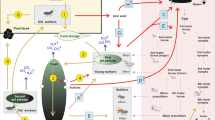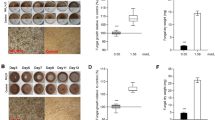Abstract
ALTHOUGH ant-plant mutualisms have been described in many ecosystems, the magnitude of the direct benefits from such relationships are hard to quantify. In Bako National Park, Sarawak, Malaysia, stunted 'kerangas' forests occur on nutrient-poor sandstone hills1–3. As trees are widely spaced and have a sparse leaf area, a significant amount of light reaches the tree trunks and enables a diverse community of epiphytes to thrive there4. One of these epiphytes, Dischidia major (Vahl) Merr. (Asclepiadaceae), has evolved unusual methods for enhancing carbon and nitrogen acquisition. We show here that a mutualistic relationship exists between ants of the genus Philidris and their host, D. major. Using stable isotope analysis, we calculate that 39% of the carbon in occupied host plant leaves is derived from ant-related respiration, and that 29% of the host nitrogen is derived from debris deposited into the leaf cavities by ants.
This is a preview of subscription content, access via your institution
Access options
Subscribe to this journal
Receive 51 print issues and online access
$199.00 per year
only $3.90 per issue
Buy this article
- Purchase on Springer Link
- Instant access to full article PDF
Prices may be subject to local taxes which are calculated during checkout
Similar content being viewed by others
References
Anderson, J. A. R. Gdns Bull. Singapore 20, 131–228 (1963).
Brünig, E. F. W. O. UNESCO Symp. Ecol. Res. Humid Trop. Vegn, Kuching 1963, 289–313 (1965).
Ashton, P. S. Malayan Nature J. 24, 151–162 (1971).
Janzen, D. H. Biotropica 6, 237–259 (1974).
Shattuck, S. O. Sociobiology 21, 1–181 (1992).
Kerr, A. F. G. Br. Scient. Proc. R. Dubl. Soc. 13, 293–309 (1912).
Griffith, W. Trans. Linn. Soc. Lond. 20, 387–390 (1846).
Huxley, C. R. Biol. Rev. 55, 321–340 (1980).
Huxley, C. R. in Insects and the Plant Surface (eds Juniper, B. & Southwood, R.) 255–282 (Arnold, London, 1986).
Winter, K., Wallace, B. J., Stocker, G. C. & Roksandic, Z. Oecologia 57, 129–141 (1983).
Treseder, K. K. thesis, Univ. Utah (1994).
Farquhar, G. D., Ehleringer, J. R. & Hubick, K. T. A. Rev. Pl. Physiol. molec. Biol. 40, 503–537 (1989).
Keeling, C. D., Mook, W. G. & Tans, P. P. Nature 277, 121–123 (1979).
DeNiro, M. J. & Epstein, S. Geol. Soc. Am. Abstr. Prog. 8, 834–835 (1976).
DeNiro, M. J. & Epstein, S. Geochim. cosmochim. Acta 42, 495–506 (1978).
Schoeninger, M. J. & DeNiro, M. J. Geochim. cosmochim. Acta 48, 625–639 (1984).
Davidson, D. W. & Epstein, W. W. in Vascular Plants as Epiphytes (ed. Lüttge, U.) 200–233 (Springer, Heidelberg, 1989).
Rico-Gray, V., Barber, J. T., Thien, L. B., Ellgaard, E. G. & Toney, J. J. Am. J. Bot. 76, 603–608 (1989).
Benzing, D. H. Bull. Torrey Bot. 97, 109–115 (1970).
Madison, M. Selbyana 5, 107–115 (1979).
Gay, H. Biol. J. Linn. Soc. Lond. 50, 221–233 (1993).
Huxley, C. R. New Phytol. 80, 231–268 (1978).
Rickson, F. R. Am. J. Bot. 66, 87–90 (1979).
Fisher, B. L., Sternberg, L. S. L. & Price, D. Oecologia 83, 263–266 (1990).
Ehleringer, J. R. & Osmond, C. B. in Plant Physiological Ecology (eds Pearcy, R. W., Ehleringer, J. R., Mooney, H. A. & Rundel, P. W.) 281–300 (Chapman & Hall, London, 1991).
Author information
Authors and Affiliations
Rights and permissions
About this article
Cite this article
Treseder, K., Davidson, D. & Ehleringer, J. Absorption of ant-provided carbon dioxide and nitrogen by a tropical epiphyte. Nature 375, 137–139 (1995). https://doi.org/10.1038/375137a0
Received:
Accepted:
Issue Date:
DOI: https://doi.org/10.1038/375137a0
This article is cited by
-
Nitrogen fixation by diverse diazotrophic communities can support population growth of arboreal ants
BMC Biology (2022)
-
The symbiosis between Philidris ants and the ant-plant Dischidia major includes fungal and algal associates
Symbiosis (2021)
-
Consistent patterns of fungal communities within ant-plants across a large geographic range strongly suggest a multipartite mutualism
Mycological Progress (2021)
-
Lycaenid-tending ants can contribute to fitness gain of the infested host plants by providing nutrients
Arthropod-Plant Interactions (2020)
-
Dependence of epiphytic community on autochthonous and allochthonous sources of nitrogen in three forest habitats of southern Vietnam
Plant and Soil (2019)
Comments
By submitting a comment you agree to abide by our Terms and Community Guidelines. If you find something abusive or that does not comply with our terms or guidelines please flag it as inappropriate.



